 Giuseppe Arcimboldo, Self-portrait, Prague: Národní galerie.
Giuseppe Arcimboldo, Self-portrait, Prague: Národní galerie.
Who was Giuseppe Arcimboldo?
Giuseppe Arcimboldo (1527-1593) was an Italian painter who is best known for his portraits made entirely of objects such as fruits, vegetables, flowers, and animals. His unique style of portraiture, known as "composite heads," was a blend of still life and portraiture, and it was widely popular among the aristocracy of the late 16th century.
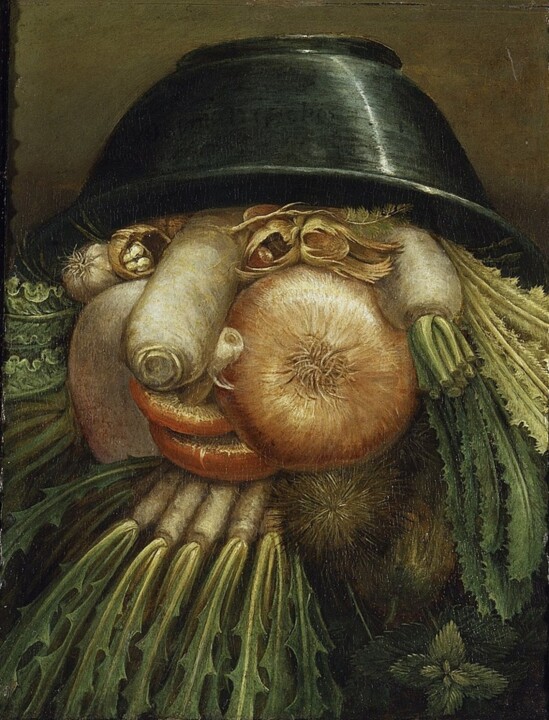 Giuseppe Arcimboldo, The Ortolan or Vegetables in a Bowl (Natura morta reversibile). Oil on panel. Cremona: Ala Ponzone Civic Museum.
Giuseppe Arcimboldo, The Ortolan or Vegetables in a Bowl (Natura morta reversibile). Oil on panel. Cremona: Ala Ponzone Civic Museum.
Life and training
Arcimboldo was born in Milan, Italy and trained under his father, Biagio Arcimboldo, a painter and miniaturist. He began his career as a designer of stained glass windows and frescoes, but he soon became known for his innovative portrait paintings, which were unlike anything seen before. Instead of depicting his subjects in a traditional manner, Arcimboldo created composite portraits using objects such as fruits, vegetables, flowers, and even animals, arranged in such a way as to resemble the features of a human face.
His work gained him the favor of the Habsburg court, and he was appointed court painter to the Holy Roman Emperor Maximilian II in 1562. Arcimboldo continued to work for the Habsburgs for the rest of his life, creating portraits of the emperor and other members of the court as well as allegorical paintings and designs for court festivities.
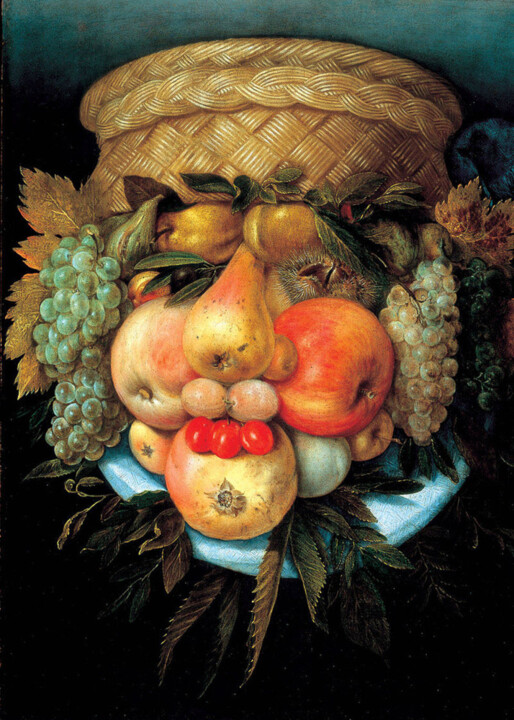 Giuseppe Arcimboldo, Reversible head with fruit basket, 1590. New York: French & Company.
Giuseppe Arcimboldo, Reversible head with fruit basket, 1590. New York: French & Company.
Subjects and style
Arcimboldo's portraits were highly imaginative and playful, and they often had a symbolic meaning that was related to the subject of the portrait. For example, a portrait of a librarian might be composed entirely of books, while a portrait of a gardener might be made up of flowers and vegetables.
Arcimboldo's work was highly varied and he explored a wide range of subjects. Some of his most common themes include portraits of emperors and rulers, as well as allegorical representations of the four seasons, the four elements, and the four seasons of life. He also created portraits of animals and natural objects, such as fruit and vegetables.
In general, Arcimboldo's paintings were highly imaginative and often contained multiple layers of meaning. He was known for his use of symbolism and allegory, as well as his interest in the natural world and the relationship between humans and nature.
What are the most famous works of Joseph Arcomboldo?
 Giuseppe Arcimboldo, Winter (1563). Vienna: Kunsthistorisches Museum.
Giuseppe Arcimboldo, Winter (1563). Vienna: Kunsthistorisches Museum.
- "Four Seasons" (c. 1563): This series of four paintings depicts each of the seasons as a portrait made up of objects associated with that time of year, such as flowers and fruits for spring and summer, and grains and vegetables for autumn and winter.
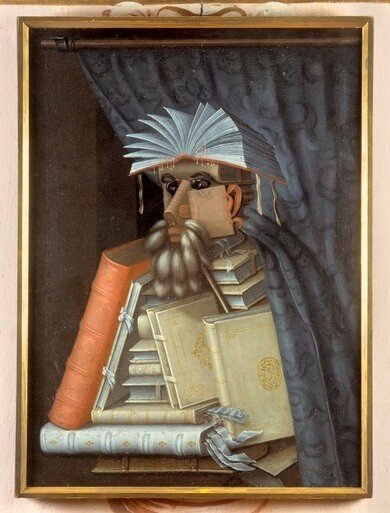 Giuseppe Arcimboldo, The Librarian, 1570. Oil on canvas, 97 x 71 cm. Håbo: Skokloster Castle.
Giuseppe Arcimboldo, The Librarian, 1570. Oil on canvas, 97 x 71 cm. Håbo: Skokloster Castle.
- "The Librarian" (1566): This portrait of a librarian is composed entirely of books, with the spines forming the subject's facial features.
 Giuseppe Arcimboldo, Water, second half of the 16th c. Oil on canvas, 65 x 53 cm. Brussels: Royal Museum of Fine Arts of Belgium.
Giuseppe Arcimboldo, Water, second half of the 16th c. Oil on canvas, 65 x 53 cm. Brussels: Royal Museum of Fine Arts of Belgium.
- "Water" (1566-70): This painting is part of a series depicting the four elements (water, air, fire, and earth) as human figures made up of objects associated with their respective element. In "Water," the figure is composed of fish, seaweed, and other aquatic creatures.
 Giuseppe Arcimboldo, Vertumnus, 1590. Oil on panel, 70×58 cm. Håbo: Skokloster Castle.
Giuseppe Arcimboldo, Vertumnus, 1590. Oil on panel, 70×58 cm. Håbo: Skokloster Castle.
- "Vertumnus" (c. 1590): This portrait depicts the Roman god of seasons and change as a composite of fruits, vegetables, and flowers. It was likely painted as a gift for the Holy Roman Emperor Rudolf II.
- "The Cook" (1570): This portrait of a cook is composed entirely of kitchen utensils and food, with pots and pans forming the subject's hat and clothing, and vegetables and meat forming the facial features.
 Giuseppe Arcimboldo, Spring, 1563. oil on canvas, 76 x 64 cm. Paris: Louvre.
Giuseppe Arcimboldo, Spring, 1563. oil on canvas, 76 x 64 cm. Paris: Louvre.
Focus on “La Primavera” (The Spring)
Giuseppe Arcimboldo's "Spring" depicts the season of spring through a composite portrait of a woman made up of various natural elements.
In La Primavera, the woman's face is composed of flowers, leaves, and other plants that are traditionally associated with spring. Her hair is made up of a nest with eggs, symbolizing new life and fertility. The painting also features a variety of animals, including birds, butterflies, and a snail, which further emphasize the theme of spring and the natural world.
The painting is considered a masterpiece of the Mannerist style, characterized by its complex composition and attention to detail. Arcimboldo was known for his inventive and imaginative portraits, which often featured allegorical and symbolic elements.
Spring’s meaning
The painting is part of a series of four seasons, and it depicts the season of spring through a portrait made entirely of plants and flowers.
The portrait is composed of a variety of colorful blooms, including roses, lilies, daisies, and other wildflowers, arranged in such a way as to create the features of a human face. The flowers form the hair, eyebrows, nose, lips, and chin of the portrait, while the leaves and stems make up the rest of the image.
The painting is an example of Arcimboldo's unique style, which combined natural elements with the human form to create striking and whimsical images. It was intended to evoke the beauty and abundance of spring, with its profusion of blossoming plants and flowers.
Arcimboldo's "Spring" is also considered a commentary on the art and science of his time. The painting reflects the increasing interest in botany and the natural world, as well as the growing fascination with the human form and its relationship to nature. It also demonstrates Arcimboldo's skill in using composition and color to create a visually stunning work of art.
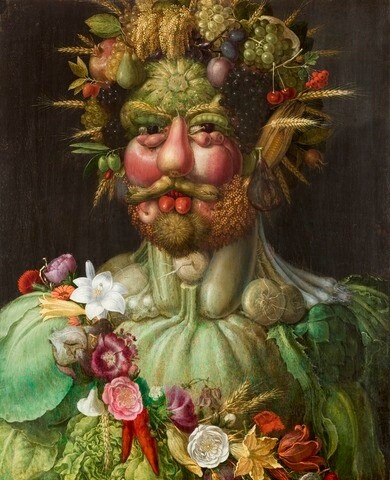 Giuseppe Arcimboldo, Vertumnus, 1590. Oil on panel, 70×58 cm. Håbo: Skokloster Castle.
Giuseppe Arcimboldo, Vertumnus, 1590. Oil on panel, 70×58 cm. Håbo: Skokloster Castle.
Focus on Arcimboldo’s Vertumnus
Giuseppe Arcimboldo's "Vertumnus" is one of his most famous works. It is a portrait of the Holy Roman Emperor Rudolf II in the guise of Vertumnus, the Roman god of change and seasons.
The portrait is made up of a variety of fruits, vegetables, and flowers, arranged in such a way that they form the features of the emperor's face. The composition is both imaginative and realistic, with each individual object carefully selected and arranged to create a striking likeness of Rudolf II.
"Vertumnus" is notable not only for its artistic merit but also for its symbolic significance. The image of Vertumnus, who was known for his ability to change his form, was a fitting representation of Rudolf II, who was famous for his eclectic tastes and interests. The painting was also intended as a tribute to the emperor, who was a patron of the arts and sciences and who had a particular interest in alchemy and the occult.
Today, "Vertumnus" is considered a masterpiece of Renaissance art and is housed in the Skokloster Castle in Sweden.
 Giuseppe Arcimboldo, Flora, c. 1589, Oil on panel, 73 × 56 cm. Private collection.
Giuseppe Arcimboldo, Flora, c. 1589, Oil on panel, 73 × 56 cm. Private collection.
Focus on Arcimboldo’s Flora
Giuseppe Arcimboldo's "Flora" is a painting that depicts a woman's face made entirely out of flowers.
The painting is part of a series of four seasons, with "Flora" representing spring. The flowers used to create the portrait are all in bloom during the spring, and their delicate petals and vibrant colors give the portrait a lively and fresh feeling.
Arcimboldo's use of flowers to create a portrait is an example of his creativity and skill as an artist. The way he arranged the flowers to form the woman's face is masterful, and the result is a portrait that is both beautiful and unique.
 Giuseppe Arcimboldo, The Lawyer, 1566. Oil on panel, 64 × 51 cm. Stockholm: Nationalmuseum.
Giuseppe Arcimboldo, The Lawyer, 1566. Oil on panel, 64 × 51 cm. Stockholm: Nationalmuseum.
What were the interpretations of Arcimboldo Giuseppe's work?
One common interpretation of Arcimboldo's work is that it represents a celebration of the natural world. By depicting humans as part of the natural world, Arcimboldo was able to challenge the prevailing idea that humans were somehow separate from and superior to the natural world. His portraits are also seen as a playful and lighthearted tribute to the beauty and diversity of the natural world.
Another interpretation of Arcimboldo's work is that it reflects the Renaissance fascination with the human form and the possibilities of artistic expression. By using unconventional materials to create his portraits, Arcimboldo was able to push the boundaries of what was considered acceptable in art and challenge traditional notions of beauty.
In addition, some scholars have interpreted Arcimboldo's portraits as a form of political satire. During his time, many European rulers were obsessed with displaying their wealth and power through lavish banquets and feasts. By creating portraits made up of food and other objects associated with such feasts, Arcimboldo may have been making a commentary on the decadence and excess of the ruling classes.
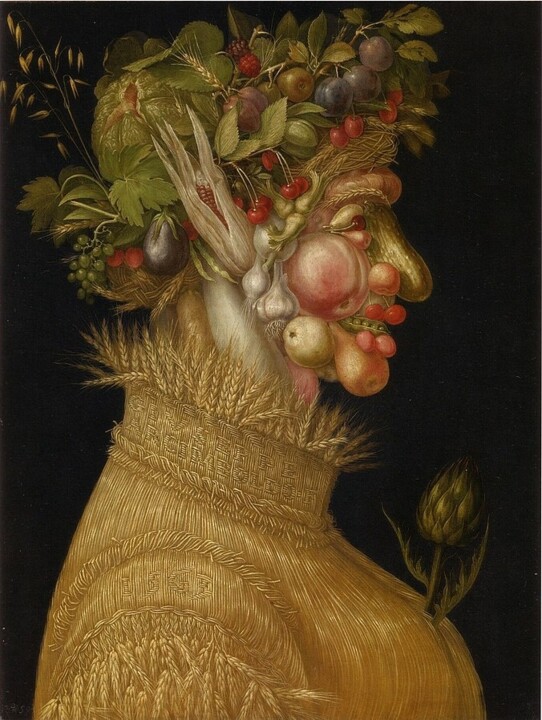 Giuseppe Arcimboldo, Summer, 1563. Oil on linden tree, 67 x 50.8 cm. Vienna: Kunsthistorisches Museum.
Giuseppe Arcimboldo, Summer, 1563. Oil on linden tree, 67 x 50.8 cm. Vienna: Kunsthistorisches Museum.
What is the legacy left by Arcomboldo Giuseppen's work to the art world?
Giuseppe Arcimboldo was an Italian Renaissance painter known for his highly imaginative and surreal portraits made up of various objects, such as fruits, vegetables, flowers, and animals. His unique style had a lasting impact on the art world, influencing later artists and movements in several ways.
One of the most significant contributions of Arcimboldo's work was his inventive use of symbolism and allegory. His portraits were not merely whimsical arrangements of objects, but often contained hidden meanings and references to contemporary social and political issues. This use of symbolism would become a hallmark of many later art movements, including Surrealism and Pop Art.
Arcimboldo's work also broke with the traditional notion of portraiture, which typically focused on realistic depictions of human subjects. By using non-human objects to create portraits, Arcimboldo challenged the viewer's perception of what a portrait could be, opening up new avenues for experimentation and creative expression.
Finally, Arcimboldo's work was influential in the development of the Baroque style, which emerged in the decades following his death. Baroque artists often employed similar techniques of illusion and symbolism in their work, and many of them were inspired by Arcimboldo's unconventional approach to portraiture.
Are there any artists who have imitated the work of Giuseppe Arcimboldo?
Yes, there have been many artists who have imitated the work of Giuseppe Arcimboldo.
One of the most famous imitators of Arcimboldo was the Belgian surrealist artist René Magritte, who created several works inspired by Arcimboldo's style. Magritte's paintings often featured ordinary objects arranged in a way that creates a new and unexpected image, much like Arcimboldo's portraits.
Another artist who was heavily influenced by Arcimboldo was the German painter Max Ernst. Ernst's "The Robing of the Bride" (1940-1941) is a clear homage to Arcimboldo's style, with a portrait made up of objects such as a bird's nest and a fish.
Other contemporary artists who have been influenced by Arcimboldo include Salvador Dali, Picasso, and David Hockney.
 Giuseppe Arcimboldo, Fire, 1566. Lime, 66.5 x 51 cm. Vienna: Kunsthistorisches Museum.
Giuseppe Arcimboldo, Fire, 1566. Lime, 66.5 x 51 cm. Vienna: Kunsthistorisches Museum.
How to summarize the artistic work of Giuseppe Arcimboldo in five points?
Giuseppe Arcimboldo was an Italian Renaissance painter known for his imaginative and unconventional portraits. Here are five key points to summarize his artistic work:
- Arcimboldo's portraits were often made up of unusual elements such as fruits, vegetables, flowers, or animals, arranged in a way that formed a recognizable image.
- His paintings were often symbolic, representing concepts such as the seasons, the elements, or the virtues.
- Arcimboldo's portraits were highly detailed and meticulously executed, showing his skill as a painter.
- He was an innovative artist, experimenting with new techniques and styles, and pushing the boundaries of traditional portraiture.
- Arcimboldo's work had a lasting impact on art, influencing later artists such as the Surrealists and inspiring new ways of thinking about portraiture and representation.
Here are some important quotes about Giuseppe Arcimboldo:
- "The most famous and talented painter in the world." - Emperor Rudolf II, who was a patron of Arcimboldo
- "Arcimboldo seems to have explored every possible visual pun and optical illusion." - The Art Story Foundation
- "Arcimboldo was a master of inventiveness and wit." - The National Gallery of Art
- "Arcimboldo's paintings were a celebration of the beauty and diversity of the natural world." - The J. Paul Getty Museum
- "Arcimboldo's work is unique in the history of art, and remains as intriguing and captivating today as it was when it was first created." - The Royal Academy of Arts
- "Arcimboldo's paintings are both whimsical and profound, a true testament to the power of the human imagination." - The Metropolitan Museum of Art
- "Arcimboldo's art is not only visually delightful, but also intellectually stimulating." - The Museum of Fine Arts, Houston
- "Arcimboldo's portraits are a celebration of the human spirit, and an exploration of the mysteries of identity." - The Art Institute of Chicago
- "Arcimboldo's paintings are a reminder of the boundless creativity of the human mind." - The Louvre Museum
- "Arcimboldo's art is a testament to the beauty and complexity of the natural world, and a celebration of the ingenuity and creativity of the human mind." - The Smithsonian American Art Museum


 Jean Dubreil
Jean Dubreil





